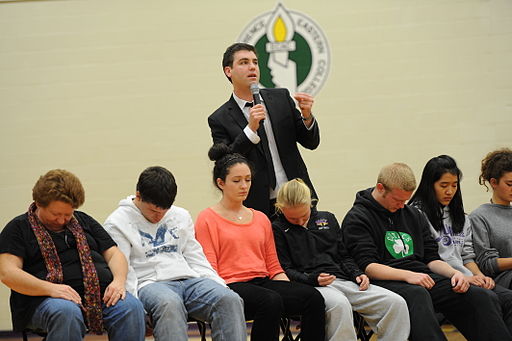Thoughtstorm
2015
Five Creative Formats to Make Company Presentations Thrilling
 We’ve all been there. We’ve faked interest. We’ve endured them. We’ve pinched ourselves to stay alert. We’ve sat through boring presentations for the sake of greater good of humanity.
We’ve all been there. We’ve faked interest. We’ve endured them. We’ve pinched ourselves to stay alert. We’ve sat through boring presentations for the sake of greater good of humanity.
Not another post on how to design your PowerPoint slides. Not even about how PowerPoint is the worst tool of all times. Here we talk about getting creative with the presentation format itself.
Format 1: Pecha Kucha (Pe-chak-cha)
Slides: 20
Speaking Time: 20 seconds per slide
Total Time: 6 minutes 40 seconds
Slides change automatically. You have to keep the pace constant and there’s no going back to a previous slide. This forces people to keep only the most important points in, eliminates redundancy and kills boredom.
Restrictions and rules force people to think creatively and to design their presentations. You don’t have the luxury to ramble on. Also, you’re forced to practice before you present—that makes all the difference. This format can be used in organisations to make key design presentations and so on.
Sample Pecha Kucha presentation:
For more information on the format visit: http://www.pechakucha.org/
Format 2: Ted Talk Like Format
If the speakers are telling success stories that are awe inspiring, you don’t want to rush them, and you don’t want to allow them to talk forever.
This format will have the following requirements:
- Moderating who presents, and how they present
- Formal editing of the story and presentation practice
- Setting the stage and using creative props
- Creating an event around the presentations
- Packing a punch in the presentation by telling a story
Speaking Time: 15 minutes
While anyone can participate in a Pecha Kucha as long as you’re passionate and have a story to tell, Ted Talks present accomplishments of people who have done something extraordinary. Use this format in your organisation to share success stories.
Format 3: Interactive Presentations
Slides: 10
Speaking Time: 30 seconds
Total Time: 5 minutes
Q&A Time: 5 minutes
Special Rule: In at least 5 slides the presenter should involve the audience in an interactivity like a question, a show of hands, a game, a response, a puzzle, a trick (it’s an ocean of possibilities).
This format will ensure that the audience is as much on their toes as the speaker. Giving equal time to Q&A ensures that people can have a healthy discussion around what is presented.
Borrow from Your Local Culture
Look around you. There’ll be local traditions of presentation. Use them in office. They’ll make people creative, and more candid.
Format 4: Impromptu Responses
Slides: No PowerPoint or presentation tools, only narration
Rules: People present in teams.
Speaking Time: Each team gets 5 minutes to sing/narrate a story/a poem/a script etc. and 5 minutes to compose a response. In the time that the next team composes, the first team answers questions.
In organizations this can work well where you fear that people don’t bring their human side to a presentation! It can be used to make employees more aware of local issues facing an organization or to make social causes meet song writing.
Local Association
In a small, sleepy town in Nothern India, a Hindu priest came up with the idea of the Jawabi Kirtan--A format in which teams of singers meet from all over, and the first team sings about a social topic for 45 minutes. The competing team gets 30 minutes to prepare (a song) in response to the first song. Although this was a leisure time activity, it made a lot of people aware about the social issues facing their region.
Take Insipiration from Movies: Run Lola Run, Rashomon etc.
In the film Run Lola Run, Lola needs to arrange a huge sum of money in 20 minutes to save her boyfriend. Each decision that Lola makes/each event affects her story and the end outcome. Can we make a presentation format based on this?
Format 5: Different Routes - One Story
Theme: An issue with several paths to an end.
Rules: Create groups based on paths that each individual believes in.
Story telling: Each group tells the same story that follows a different path. They will have to logically support how the path will lead to a desired result. Groups are free to create their route with common elements with other teams.
Time: 6 minutes per team
Debate: 4 minutes debate time to argue about the problems opposing teams foresee on the path.
Use this format where you feel that teams need to be able to see different perspectives and debate alternative paths to a solution.
Go ahead and make your own creative formats. Don't forget to share them with us.
References: Image of hypnotized people: By Nazareth College [CC BY 2.0 (http://creativecommons.org/licenses/by/2.0)], via Wikimedia Commons
Contact us
Write to us and we'll get back to you soon. Or feel free to call us.
Phone: +91 99215 90789
Email: anchalmanocha@designstorm.in
Address: 103, Ilex Bliss, Veerbhadra Nagar, Baner,
Pune, Maharashtra, India 411 045.